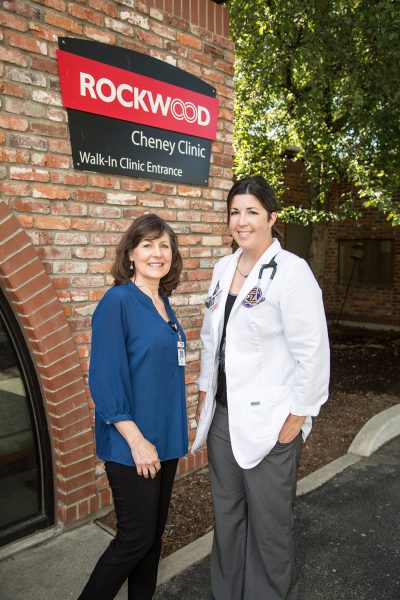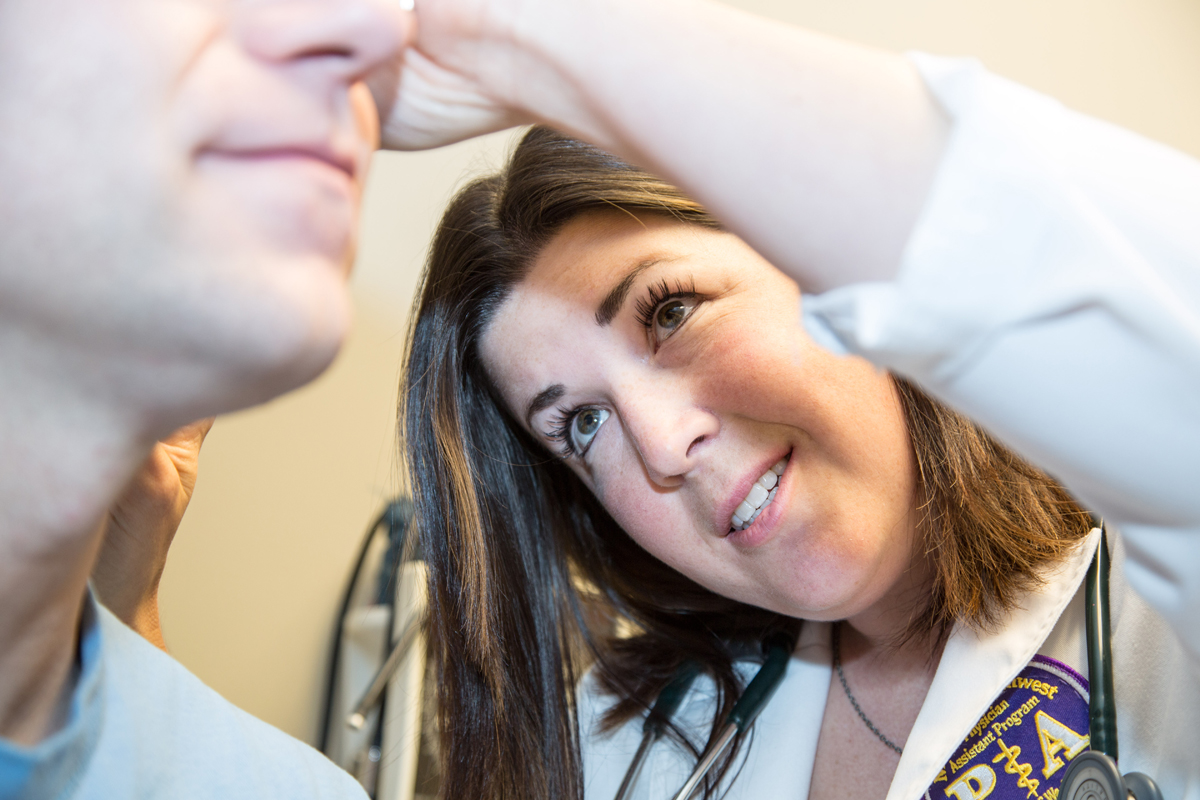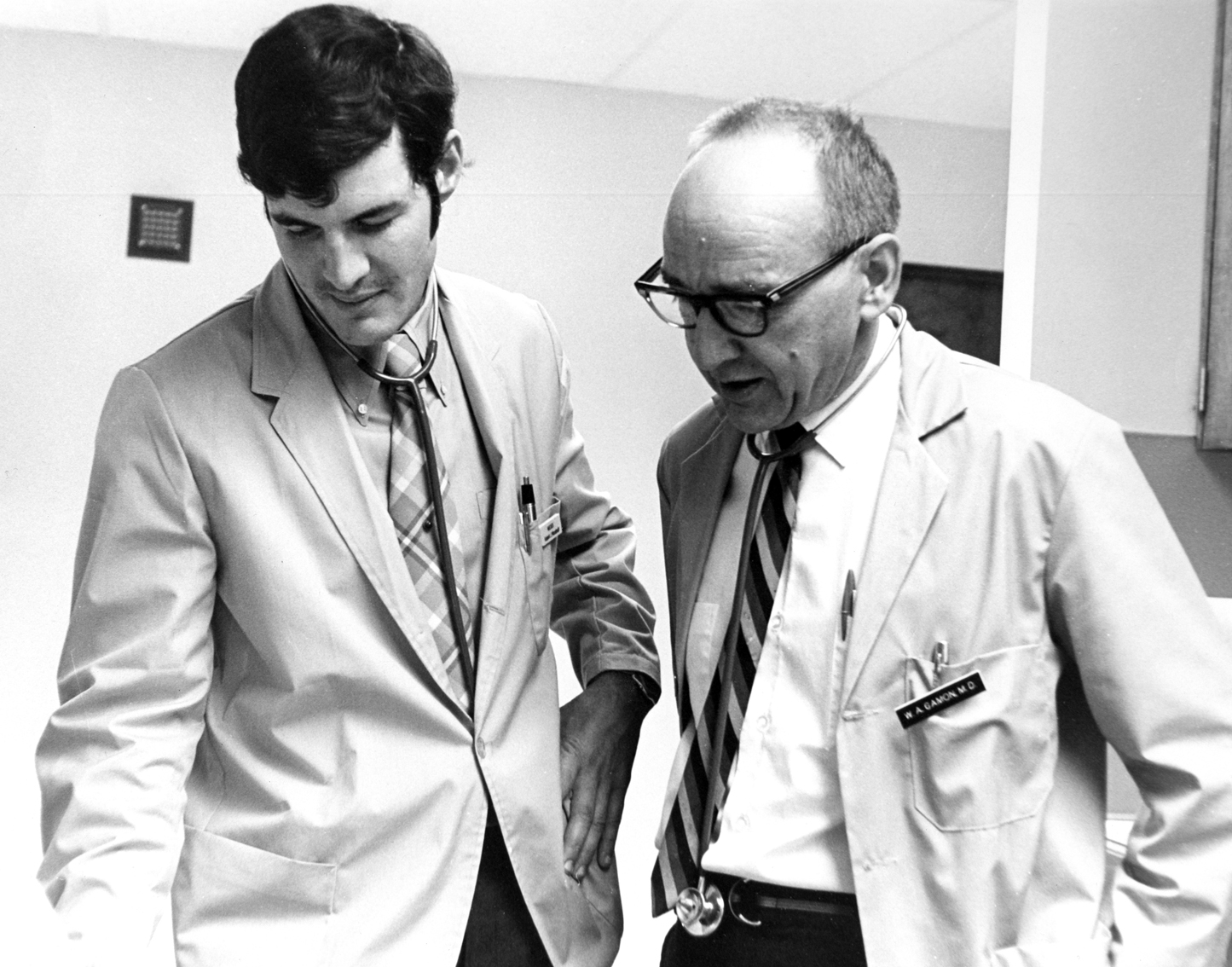Tracey Hopper is at the Rockwood Cheney Clinic in Cheney, WA, where she is fulfilling her family medicine preceptorship at the conclusion of her physician assistant studies with MEDEX Northwest.
“I can’t believe I’m here,” she tells us. “I put so much time and effort into the one application to PA school. I know that everybody says I’m insane to have only applied to one school, but I just knew that MEDEX was for me, and that it was really the only option that I had.” To this day Tracey is amazed that she was accepted into the program on her first attempt.
But then, after spending time with Tracey, you easily see why she was selected. She’s a mission fit, committed to the rural underserved, the very same target population that the MEDEX founder, Dr. Richard Smith, had in mind when he designed the UW physician assistant program back in 1967.
Tracey Hopper is from Newman Lake, WA—population 4,471. About 30 minutes outside of Spokane, the community lies near the state lines of Washington and Idaho. “We’re an underserved, understaffed population,” she explains.
Tracey started her medical career as an EMT with the local fire department. “You responded by pager, and there was a 20 to 25 minute wait time for advanced life support to get on scene.”

Carol Gahl, PA-C and Tracey Hopper outside the Rockwood Cheney Clinic. Carol is Tracey’s preceptor at the clinic.
After a year in that role, Tracey realized the need for higher-level providers in her community. She decided to go back to school to become an ILS Technician. “Intermediate Life Support is a halfway step between a basic EMT and a paramedic,” she says.
This allowed Tracey a broader scope of practice. “Not quite to the paramedic level, but it gave me the ability to provide a bit higher services to the patients we have out there,” she says. Shortly after that, she realized once again the need for more education in order to better serve people. Because her scope was so limited, she returned to school to take some nursing prerequisites. At the same time, she started working at an ambulance company in nearby Spokane.
Even while employed as an ILS tech with AMR ambulance, Tracey didn’t feel like that was enough. She began work as an ER technician with Providence Holy Family Hospital in Spokane. She’d been taking prerequisites for nursing school but, after watching how the nurses interacted in the ER, decided not to pursue a nursing career any further. Tracey explains.
“I’m an independent provider. I like to be able to walk into my patient’s room or onto a scene and be able to look at a patient, interpret what’s going on with them, and then act. I don’t like the nursing role where you have a physician overseeing you. You get a little bit of permission before you’re able to really do anything. I like to know what my scope is and be able to act within that. Obviously, if there are questions, I can go to my medical director.”
“I’m an independent provider. I like to be able to walk into my patient’s room or onto a scene and be able to look at a patient, interpret what’s going on with them, and then act. I don’t like the nursing role where you have a physician overseeing you. You get a little bit of permission before you’re able to really do anything. I like to know what my scope is and be able to act within that. Obviously, if there are questions, I can go to my medical director.”
After three years in the ER while still working for AMR, Tracey chose paramedic school over nursing. “I became a paramedic and was working with AMR here in Spokane for about four and a half years.”
In the back of her mind, Tracey knew she wanted more. As a paramedic she continued to run up against the problem of a large scope and places where she couldn’t go further. “You know what your patient needs, yet you can’t provide that for them.”
Nursing was out and, now age 35, Tracey felt she was a bit too old for the path to becoming an MD with its requisite four years of schooling and a minimum three years of residency. All signs were pointing to the physician assistant profession. Tracey started getting her application for MEDEX in order, and was accepted to the Spokane site.
“There was only one application and only one school,” she says. “MEDEX’s mission statement was what I was looking for. I come from a rural under served community. I knew that I enjoyed family practice, even though I have a strong background in emergency medicine. I wanted to be able to enjoy the continuity of care and see people as they grow, as their disease either progresses or we’re able to treat them and make them better.”
The Rockwood Cheney Clinic in Cheney, WA and MEDEX Northwest go way back. Starting with Bob Woodruff of MEDEX Seattle Class 1 some 48 years ago, the Cheney Clinic has a long history as a teaching site for UW physician assistant students. Like Tracey Hopper, current MEDEX Program Director Terry Scott, MPA, PA-C, fulfilled his family medicine preceptorship at the Cheney Clinic in 1993. Carol Gahl, PA-C, a graduate of MEDEX Seattle Class 27 from 1995, acts as Tracey’s preceptor during her four months in Cheney.
“They have this excellence for providing spots for students here,” Tracey says of the Rockwood Cheney Clinic. “I just feel that is invaluable.”
Cheney is home to Eastern Washington University, so the patient population is a broad mix of locals and college students, including international students. In many ways the presence of the University puts the clinic on par with an urban care facility. “It’s a walk-in clinic,” Tracey says. “But basically, the community uses this clinic as their urgent care. We have people who come from as far as Ritzville.”
Geographically, the Cheney Clinic is located before the ER, so oftentimes the clinic gets people coming in for urgent care. “We have to manage them acutely, and then send them downtown,” she says. “For the most part Cheney Clinic has been here the longest. People know we’re here and there’s little else.”
For the EWU students, there’s the walk-in clinic, along with the regularly scheduled Monday through Friday hours for follow-ups, physicals, women’s health and more.
Tracey’s four-month preceptorship has been long enough to experience repeat patients. “It’s been great,” she says. “I almost feel like I’m starting to establish my own clientele, which is nice. The first month that I was here I was working a lot of the walk-in clinic, just to kind of get the feel of how things go. I’m comfortable in that environment because it’s kind of similar to how I’ve operated in the past.” A student might come in with pneumonia, for instance, and Tracey would follow up with them in a week to see how they’re doing. This is the continuity of care that she’s looking for.
With graduation near, Tracey is completing her 4-month preceptorship in Cheney and all of her six 1-month clerkship rotations. These included her first rotation in emergency medicine, followed by in-patient at St. Luke’s Rehabilitation Institute, a surgical rotation, behavioral medicine, cardiology and an elective in pediatric endocrinology at Seattle Children’s in Seattle. All required her to be like a sponge, soaking in the knowledge and experience. In their clinical year, PA students must walk into different environments and make it work. Flexibility is essential.
“This is one of the biggest challenges some of us have as students,” she says. “Everyone has a different way of learning, and there’s more than one way to skin a cat.” Throughout the past year Tracey found that her experience as an EMS provider prepared her to meet the needs of the situation.
“As an EMS I worked with various other providers, mainly career and volunteer firefighters from all over Spokane County,” she says. “Everybody has a different scope, so you modify your treatment approach accordingly. At some agencies, I’d have to step up and be that number one primary ALS role. With others I’d have to stand back and be like, ‘You guys have this, what can I do to help you?’ You learn to be malleable.”
It’s just this kind of flexibility and skill that must have caught the attention of the leadership at the Rockwood Cheney Clinic, because they’re offered to hire Tracey once she graduates and passes the PA National Certification Exam. “It’s just a great environment,” she says. Tracey has high praise for Dr. Charles Hough and Dr. Tom Koeske, both having been with the clinic for over 30 plus years. “The have the patience and ability to help you understand where you’re missing something, but without making you feel small or unintelligent. That’s ultimately why I want to stay out here. I’m putting myself in an environment where not only are there great doctors, but all of the advanced practice providers too. The learning curve is going to be steep but invaluable. I couldn’t pay to get that anywhere else.”
Now days from graduating as part of MEDEX Spokane Class 18, Tracey reflects on the past two years with her cohorts. “It’s neat to see everybody progress,” she says. “Where we were a year ago compared to where we are now, it’s not until we get out into clinical rotations that it actually really starts to set in. Once you see something you’re going to forever remember it. Talking with my fellow students, it’s really interesting to see the base of knowledge that we’ve all acquired. I think they’re all going to make amazing providers. Just a year ago, if you would’ve asked me or one of my other classmates a question about some specific disease process, we might not have been able to come up with the right answer. But after the clinical rotations and what we’ve seen, it’s right on the tip.”
“It’s amazing to see how our base of knowledge changes from one year to the next. I’m hoping that in one year, five years from now, I’m going to be even better.”























